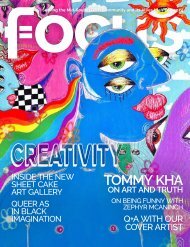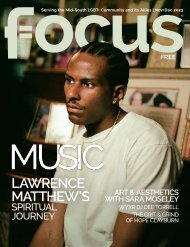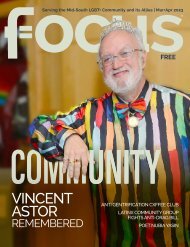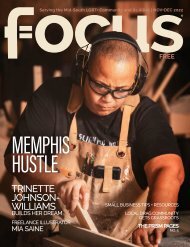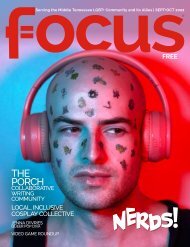2023 Issue 5 Sept/Oct Focus - Mid-South Magazine
Focus Mid-South Magazine
Focus Mid-South Magazine
You also want an ePaper? Increase the reach of your titles
YUMPU automatically turns print PDFs into web optimized ePapers that Google loves.
Only five hours from<br />
Memphis, Bentonville,<br />
Arkansas is a surprising<br />
sanctuary for fine art in the<br />
<strong>South</strong>east. Perhaps the best<br />
known spot I visited is the<br />
Crystal Bridges Museum<br />
of American Art, which lies<br />
on 120 acres of beautiful<br />
forest in the foothills of<br />
the Ozark mountains. The<br />
museum is a cultural site<br />
that not only emphasizes<br />
the visual arts, but also<br />
architecture, outdoor<br />
recreation, and culinary<br />
arts. Bentonville itself has<br />
over 140 miles of mountain<br />
biking trails and over 40<br />
miles of walking trails. A six<br />
minute drive away is The<br />
Momentary, Crystal Bridges’<br />
satellite contemporary art<br />
space. The Momentary is<br />
also accessible via shuttle<br />
from Crystal Bridges, or a<br />
short two mile walk down<br />
the Razorback Regional<br />
Greenway. Visitors of The<br />
Momentary can expect to<br />
see contemporary art, live<br />
music, and performance<br />
art, as well as participate<br />
in culinary and fine art<br />
workshops and community<br />
celebrations. The<br />
Momentary is also home<br />
to an artist-in-residence<br />
program. Both Crystal<br />
Bridges and the Momentary<br />
are free admission by the<br />
generosity of the Walton<br />
family, for the exception<br />
of the museums’ special<br />
rotating exhibitions. In<br />
addition to Crystal Bridges<br />
and The Momentary,<br />
Bentonville is home to<br />
a 21c Museum Hotel, a<br />
member of the upscale<br />
21c hotel chain offering<br />
an expansive collection of<br />
contemporary artworks and<br />
a highly-inspired upscale<br />
restaurant, The Hive. While<br />
planning my trip, I reached<br />
out to local artist and<br />
Northwest Arkansas native,<br />
Joel Parsons, for advice<br />
on crafting the perfect art<br />
weekend. With his helpful<br />
suggestions, I formulated<br />
a plan that ensured I could<br />
taste a little of what the<br />
region has to offer.<br />
Upon arriving in<br />
Bentonville, I advise parking<br />
in the town square. I parked<br />
in the lot behind the 21c<br />
Museum Hotel, a spot I<br />
knew I would be visiting<br />
after my museum trip. From<br />
there, I suggest heading<br />
towards the forest and<br />
taking the Crystal Bridges<br />
trail to the Art Trail, entering<br />
the museum from the<br />
<strong>South</strong> Entrance. Along the<br />
trail, you will encounter<br />
one of James Turrell’s<br />
Skyspaces. The Skyspace,<br />
The Way of Color (2009),<br />
is a large round structure<br />
protruding from a hillside<br />
on the campus grounds.<br />
While walking through the<br />
doorway of the sculpture,<br />
the perception of space<br />
seems surreal; the curved<br />
stone walls create a sense<br />
of confinement, while the<br />
circular opening at the top<br />
of the structure exposes<br />
an intimate peek into the<br />
atmosphere. If you have the<br />
opportunity to witness the<br />
work at sunrise or sunset,<br />
you will be captivated by<br />
how Turrell uses LED lighting<br />
to manipulate your sense<br />
of light, space, and nature.<br />
Continuing down the path,<br />
you will cross many creeks<br />
and waterfalls. I recommend<br />
wearing good walking shoes<br />
as there is some elevation<br />
change, though the Crystal<br />
Bridges Trail and Art Trail<br />
are both ADA accessible.<br />
While approaching the<br />
south entrance, you will<br />
pass some well-known<br />
artworks, such as Louise<br />
Bourgeois’s Maman (1999),<br />
Yayoi Kusama’s Narcissus<br />
Garden (1966-present),<br />
and a corten steel rendition<br />
of Robert Indiana’s LOVE<br />
sculpture (1966-1999). 1<br />
Situated to the right of the<br />
<strong>South</strong> Entrance is Frank<br />
Lloyd Wright’s Bachman-<br />
Wilson House. Moshe Safdie,<br />
the architect of Crystal<br />
Bridges, shared Wright’s<br />
sentiment that architecture<br />
should be responsive to<br />
its environment, designing<br />
the museum with respect<br />
to the Ozarks. Embracing<br />
horizontality, both Safdie<br />
and Wright examine the<br />
landscape's potential to<br />
heighten the architecture<br />
and vice versa. More<br />
information about the<br />
history of the Bachman-<br />
Wilson house is available<br />
in the Great Hall Corridor<br />
following the south entrance,<br />
as well as a wonderful view<br />
of the building through the<br />
museum’s expansive glass<br />
walls.<br />
Crystal Bridges’<br />
Temporary Exhibition<br />
Gallery was closed during<br />
my visit, so I instead<br />
went straight to the Early<br />
American Art galleries.<br />
The space featured a<br />
collection of portraits from<br />
American history; however,<br />
the museum proved<br />
keenly aware of how they<br />
displayed American culture<br />
in an institutional setting.<br />
Exploring multiplicities of<br />
identity, Crystal Bridges<br />
juxtaposed traditional<br />
portraits of cis-het, rich,<br />
white men of the past with<br />
those of underrepresented<br />
groups. For instance,<br />
situated between Gilbert<br />
Stuart’s George Washington<br />
[The Constable-Hamilton<br />
Portrait] (1797) and Thomas<br />
Sully’s Colonel Samuel<br />
Boyer Davis (1819) portraits<br />
of—you guessed it—old,<br />
rich, cis-het white men, is<br />
Kehinde Wiley’s Portrait of a<br />
Florentine Nobleman (2018).<br />
Wiley’s painting depicts a<br />
portrait of Shontay Haynes,<br />
a St. Louis local, in front<br />
of and intertwined with an<br />
ornate sixteenth-century<br />
floral background. Wiley’s<br />
paintings place Black<br />
individuals in the historical<br />
context of portraiture,<br />
calling attention to the<br />
identities that have been<br />
left out of history. By<br />
sandwiching Wiley’s work<br />
between two classical<br />
paintings of prominent<br />
American figures, Crystal<br />
Bridges is acknowledging<br />
and contributing to the<br />
mission of unveiling history<br />
and uplifting voices that<br />
have historically been<br />
silenced. On your way out of<br />
the Early American gallery,<br />
be sure to spend some<br />
time with William Wetmore<br />
Story’s life-size marble<br />
sculpture Sappho (1867).<br />
The work is representative<br />
of American and European<br />
interest in classical subjects<br />
and mythologies, though<br />
Story was likely unaware<br />
he was depicting a future<br />
prominent figure in LGBTQ+<br />
history and literature, whose<br />
poems are heavily coded<br />
with feminine desire. 2<br />
Mae Aur: The Guardeners, 2019.<br />
Hand cut wood, acrylic paint.<br />
Crystal Bridges Museum of<br />
American Art<br />
photo by Mud<br />
<strong>Sept</strong>+<strong>Oct</strong> <strong>2023</strong> | focuslgbt.com | Go! 25








